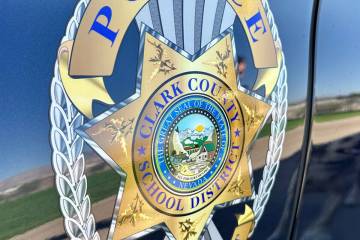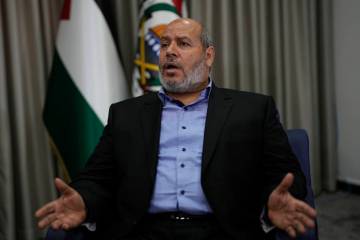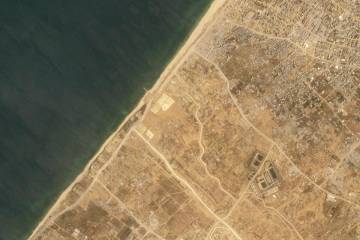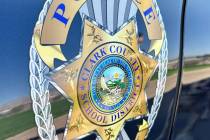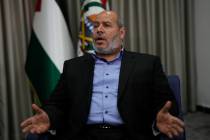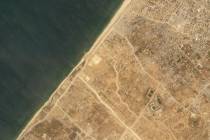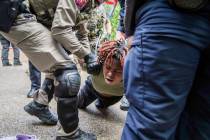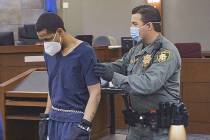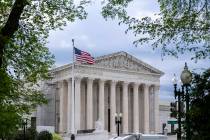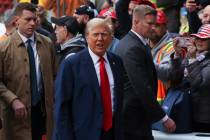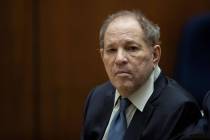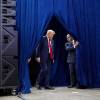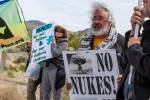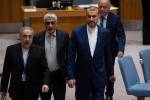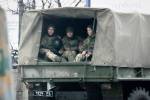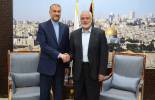Alliance honored
Jeff Chilton remembers well his reaction to the moratorium on full-scale nuclear weapons tests at the Nevada Test Site that was launched temporarily in 1992 by President George H.W. Bush and extended indefinitely by President Clinton the following year.
"Mine was devastation," said Chilton, the United Kingdom's engineer for the nuclear device that was to be put down the hole of the Icecap tower for what would have been the 25th below-ground nuclear test conducted jointly by the United States and the United Kingdom since 1961.
"I had spent two to three years working on Icecap," he said this week while he and other members of the U.K.'s Atomic Weapons Establishment erected the framework for a new exhibit at the Atomic Testing Museum.
"We flew back home and Clinton decided to pull the plug," Chilton recalled of Clinton's announcement in the summer of 1993 to extend the nine-month moratorium.
The exhibit of photographs, documents and video footage, which opens Saturday at the museum at 755 E. Flamingo Road, will mark the 50th anniversary of the 1958 Anglo-American Mutual Defense Agreement. The pact serves today as a cornerstone in the U.S.-U.K. efforts to fight the global war on terrorism by preventing nuclear weapons and materials from falling into the hands of the countries' adversaries. It also continues the scientific exchange that was carried over at the test site, 65 miles northwest of Las Vegas, as the two nations rely on subcritical nuclear experiments to check the reliability of their stockpiles.
Subcritical experiments, conducted in chambers deep underground, use tiny amounts of plutonium and are designed not to erupt into nuclear chain reactions. The first one in 1997 was about one-tenth of 1 percent the size of a full-scale nuclear test. Two U.S.-U.K. subcritical experiments have been conducted, one in 2002 and the other in 2006.
Despite the shift to subcritical experiments, the 157-foot-tall Icecap tower still stands as a reminder of the days of full-scale nuclear tests, and as an icon of the historic pact that will be the focus of the exhibit at the Atomic Testing Museum through January.
The Icecap tower was built to lower the nuclear device and diagnostic cables below the surface of the test site, where 828 nuclear blasts were conducted below ground in addition to another 100 in the atmosphere between 1951 and 1992.
The United Kingdom spent about $560 million on Icecap and the United States chipped in another $70 million. It was supposed to be a "cold shot," Chilton said, to test the concept for a potential weapons system that would have spent most of its years in an Arctic climate, such a Greenland, to thwart a potential Soviet strike. Dry ice was to be used to chill the device to minus 40 degrees Celsius.
Chilton's colleague and liaison officer for the Mutual Defense Agreement, Stephen Fisher, said the pact has weathered 50 years because it is was forged by the leaders of two countries concerned about evolving Soviet nuclear and space technologies that posed a common threat to Europe and the West. The relationship was underscored by scientific exchanges that pre-dated the agreement during the days of the Manhattan Project to develop a nuclear bomb during World War II.
"The term special relationship is often used," Fisher said.
"This agreement shows how specials this relationship is. The U.K. does things differently from the U.S. and visa versa. But scientifically both learn. And our budget is much smaller, which makes us innovative in what we're doing."
Troy Wade, president of the Nevada Test Site Historical Foundation and former Department of Energy defense programs chief during the Reagan administration, said he's always been impressed by the longevity of the Anglo-American Mutual Defense Agreement.
"The amazing thing is the 1958 agreement covers these subcritical experiments. I think that's remarkable," Wade said.
When the exhibit opens at 9 a.m. Saturday, free to the public, historian John Baylis of Swansea University in the United Kingdom will give a presentation on the development of the 1958 agreement, followed at 11 a.m. with a lecture by former Air Force Secretary Thomas C. Reed, who will discuss his book, "At the Abyss."
Then, at 2 p.m. Frank Gaffney, secretary of defense for Nuclear Forces and Arms Control Policy under President Reagan will discuss his book, "War Footing."
Contact reporter Keith Rogers at krogers@reviewjournal.com or 702-383-0308.





